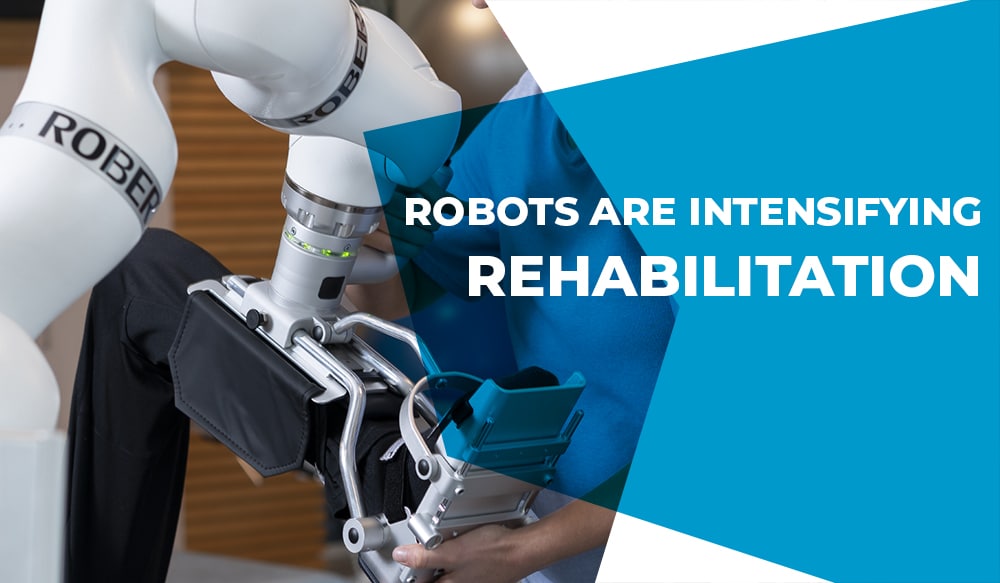
Robots are intensifying the rehabilitation in Denmark
Without overburdening physiotherapists, social workers, nurses and occupational therapists, patients in more and more municipalities are now getting a more effective rehabilitation with the help of robotics technology. The result is an enhanced progress and a more self-sufficient everyday life for the patients.
Keld Thorsen, CEO – Life Science Robotics
Professionals work hard every day to provide patients with optimal rehabilitation. Research shows that the best time frame for the greatest effect for rehabilitation is in the first 3-6 months after the injury has occurred. It is best to train with high intensity, and as much as possible to stimulate the neuroplasticity properties of the brain.
The dilemma, however, is that this big volume of training affects the physique of the rehabilitation staff looking to help the patients reach the maximum potential. Besides, a significant issue is the lack of time. If someone gets more exercise, it will be at the expense of other patients’ training time.
Therefore, it is a fact that for many Danish patients there is a discouraging difference between the actual amount of rehabilitation received and the recommended amount. Even though there is plenty of will and knowledge present.
Too few repetitions
For example, a patient in Denmark usually receives a maximum of 20 repetitions of a foot exercise to prevent the pointed foot, drop foot, edema, blood clots in the legs etc. This is the reality, although everyone agrees that there should preferably be at least 100 repetitions of the exercise.
Besides, for every week a patient lies inactive in bed, it loses four percent of muscle mass and develops stiff joints. In addition, the risk of blood clots increases significantly when not in motion. Therefore, it is important to keep the quadricep going so that it does not end up with the patients getting even worse.
The good news is that patients can get a significantly increased amount of training, without overloading the physiotherapists, healthcare professionals, nurses and occupational therapists, as well as getting an increased possibility of self-training. The great news is that some municipalities now have discovered this.
The Danes are positive
Rehabilitation robots are well on their way to gaining ground because the Danes are generally very positive about having “robots as colleagues”, seeing them as beneficial means of maintaining their welfare society. Likewise, the robots are great at facilitating self-training, which is becoming more and more of a focal point in the individual municipalities.
After thorough tests locally, several players in Denmark have chosen to use robots to intensify rehabilitation, increase self-training and at the same time relieve professional staff of too many and too heavy lifts.
The frontrunners in the use of robot technology for training are Bytoften Residence and Activity Center in Herning, VCR in Viborg, Neuro Center North in Frederikshavn, Neurocenter Østerskoven in Hobro, Lunden Residence and Rehabilitation Center in Varde, Training Centre West in Aalborg, which now have 2 robot units, the private NeuroRehab Clinic in Aalborg and Odense Universitetshospital in Odense. All of them are using an innovative robot developed in Aalborg – ROBERT®, which is also gaining ground in rehabilitation in the USA and German market for instance, at the well-known physiotherapist clinic Hellmuth and Thiel in Potsdam.
Benefits for the working environment
When a physiotherapist manually trains a paralyzed or debilitated patient, it is a very stressful, one-sided repetitive work. The working environment’s great benefit is avoiding having to lift the 15-20 kg of an adult leg weight repetitively. Or even more so if patients belong to the growing group of severely obese.
When the training takes place with the help of a rehabilitation robot, the physiotherapists can almost double their capacity. This calculation is highly relevant as a robot monthly costs represent a quarter of a physiotherapist’s salary.
By all means, the physiotherapists’ professionalism does not go unnoticed because their knowledge and assessments is mandatory to match the robot’s potential with the personal training program that the individual patient needs.
Outside office hours
At nursing homes and rehabilitation centres, there is a very rare opportunity for training on the weekends, because the physiotherapists primarily work from 8 to 15 on weekdays. With a robot that can be moved around from one room to another, there is potential for patients to have their legs and feet mobilized outside of “normal office hours” as well.
In general, there are several hard physical jobs in the healthcare sector where new technology could free up employees, allowing them to perform more complex and value-adding tasks.
Therefore, the benefits are many: increased quality of life and self-help, a healthier working environment for therapists and also higher productivity – without the corresponding higher wage costs.
The list of patient groups that may benefit from automated rehabilitation is extensive: spinal cord patients, patients with blood clots / cerebral haemorrhages, elderly patients in geriatric wards, patients on ventilators and other intensive care patients with long-term hospitalizations, multiple sclerosis patients and Amyotrophic Lateral Sclerosis (ALS) patients.
Therefore, the municipalities should consider new solutions that can profitably contribute to the overall course of treatment being effective. It is about the patients recovering quickly without unnecessary consequences. There is so much to gain from that. To everyone.